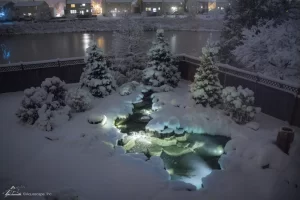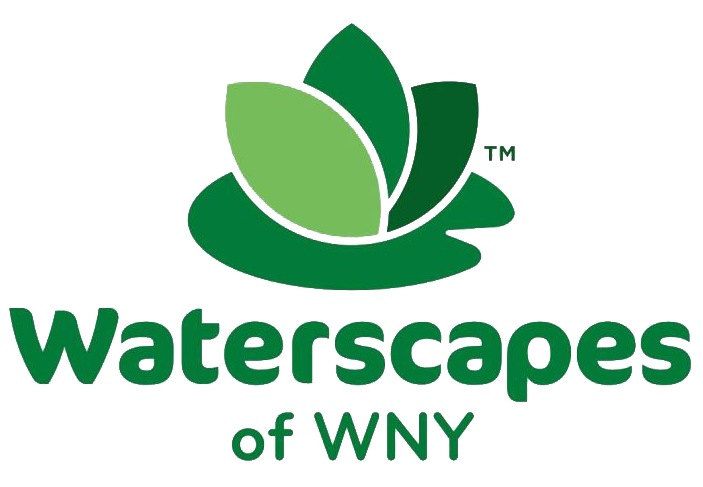
When the temperature starts to plummet, pond owners ask themselves how they can keep their pond running properly during the winter months. Follow these winter tips to keep your pond happy during the off season.
Keep a hole in the ice: Once the temperature starts to drop below freezing, you will notice the surface of your pond icing over. Your first instinct might be to rescue your fish before the pond freezes solid! No need to worry about your fish turning into ice cubes provided your pond is at least two feet deep. The fish will hibernate at the bottom of the pond where the water doesn’t freeze. You do however, need to make sure that you keep a hole in the ice for the exchange of gases so the pond doesn’t become toxic to your finned friends.
For those who run their waterfalls all winter long….
Don’t poke unnecessary holes in the ice: This hole in the ice is different from the aforementioned hole that’s necessary to keep your fish safe. In the winter you might notice ice build-up (especially around the waterfalls) that prevents your water flow from reaching the surface. Your first instinct might be to break off some of this ice which can create new holes.
The ice formations on your pond act as a barrier between the cold air outside and the water running underneath it. Busting open the ice in multiple areas exposes the running water to freezing temperatures for a second time. Now all the newly exposed water begins to freeze and creates even more ice than before. Consequentially, your water source will be depleted from this build-up of ice and you’ll find yourself having to top off your pond more frequently than you’d like.
Breaking open other small holes in your pond is also ill-advised. When you create a small hole across your pond, the water underneath will start to flow on top of the surrounding ice. This prevents your water source from running underneath the ice to reach your pump down below, and now your pond is leaking. To correct this, you need to carefully open another hole near your pump so all the water running on top of the ice will flow back into this new hole.
Watch for water running over ice buildup: Sometimes you might notice that an area of ice has water running over it and out of the pond. This can happen near the waterfalls where water tends to splash and ice builds up creating a dam. Water coming over the falls might be diverted outside of the pond when this happens. To correct this, you need to carefully open a hole where the damming occurs so water runs freely over the falls and into the pond. A good way to eliminate a buildup of ice is to pour warmer water over it to melt the ice dam.
Watch for water running over ice buildup: Sometimes you might notice that an area of ice has water running over it and out of the pond. This can happen near the waterfalls where water tends to splash and ice builds up creating a dam. Water coming over the falls might be diverted outside of the pond when this happens. To correct this, you need to carefully open a hole where the damming occurs so water runs freely over the falls and into the pond. A good way to eliminate a buildup of ice is to pour warmer water over it to melt the ice dam.
It’s vital to keep a vigilant eye on an operational pond in freezing conditions. Although creating holes in the surface ice can cause problems, keep in mind you do need at least one good-sized hole for the exchange of gas and oxygen to keep your koi alive. Creating this hole releases all the gases trapped under the ice, while also providing oxygen to your pond fish.
https://youtu.be/6q7t4GsnDkE – Check out this video from Aquascape for more winter pond tips.

Leave a Reply